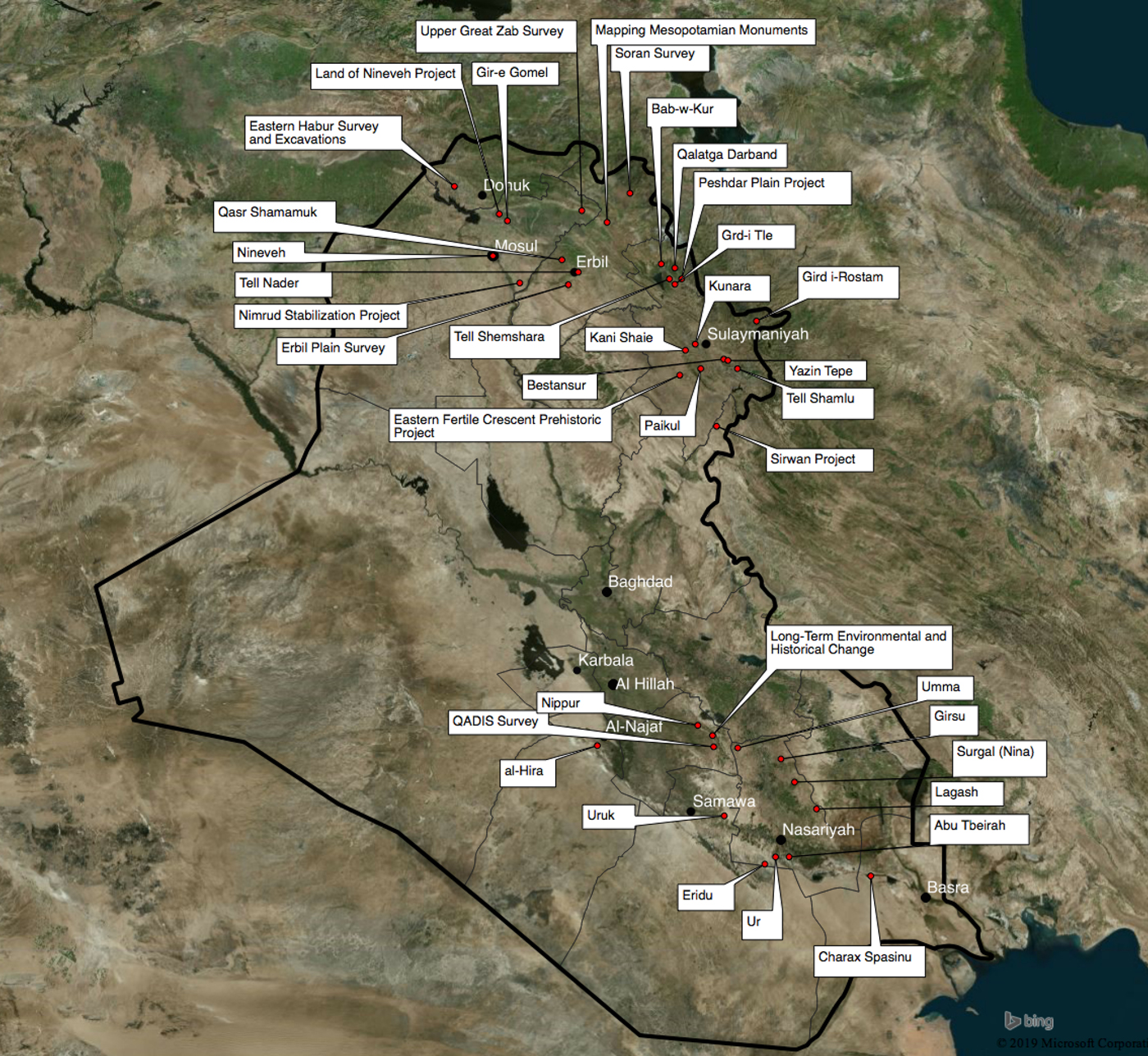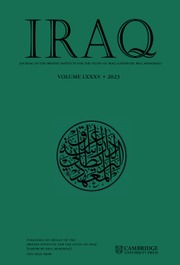(not all projects can be shown on map due to reasons of space)

Abu Tbeirah: Excavations by University of Rome La Sapienza and an Iraqi team at this 3rd millennium B.C. site (Early Dynastic-Akkadian Period) near Nasiriyah.
al-Hira: Archaeological work, including excavation and magnetometer surveys, undertaken by the German Archaeological Institute and Goethe Universität Frankfurt at this late Antique and early Medieval city near Najaf.
Bab-w-Kur: University of Copenhagen excavations on this Late Chalcolithic site near Tell Shemshara in the Rania Plain.
Ban Qala: Excavation of Late Chalcolithic materials at this small site in the Qara Dagh Valley, led by colleagues at the Freer/Sackler, University of California, Berkeley, and Suleimaniyah Antiquities Department.
Bash Tapa: Excavations in Bronze Age levels at a small site south of Erbil, with occupation from Late Chalcolithic through Medieval (especially Ninevite 5 and Middle Assyrian), led by Collège de France and CNRS Paris.
Bestansur: University of Reading excavation of this Neolithic site, part of the Central Zagros Archaeological Project (CZAP). Also has Neo-Assyrian occupation excavated by the University of British Columbia.
Charax Spasinu: Survey and excavation project led by the University of Manchester on this historic site, the port city of Alexandria-on-the-Tigris, near Basra.
Eastern Fertile Crescent Prehistoric Project: University of Liverpool-led survey focusing on landscape, environment and Palaeolithic-Neolithic sites in the region of Chamchamal.
Eastern Habur Survey: University of Tübingen excavations and survey of the region, including excavations at Bassetki (possibly ancient Mardaman) and Kemune.
Eastern Qadisiyah Region (QADIS): Archaeological survey conducted by the University of Qadisiyah and University of Bologna. Includes intensive surface survey of the site of Tell Shuruppak (Fara).
Erbil Plain Archaeological Survey (EPAS): Survey of the landscape and long-term settlement and exploitation of the region around Erbil, led by Harvard University.
Eridu: Survey, excavation and conservation project by the Iraqi-Italian Archaeological Mission at this important Ubaid-3rd millennium B.C. site.
Girsu: British Museum-led project excavating the 3rd millennium B.C. site of Girsu (modern Tello), including conservation of the bridge structure first excavated in the 1920s. Training of Iraqi archaeologists is included.
Gir-e Gomel: University of Udine and Directorate of Antiquities (Dohuk) excavations carried out on a Bronze Age settlement.
Gird-i Qala and Logardan: Mainly Late Chalcolithic sites in the Chamchamal plain, excavated by University of Paris I and IFPO.
Gird-i Qalrakh: University of Frankfurt excavations at a small multi-period site (early 3rd millennium B.C.-Islamic) in the Shahrizor plain.
Gird-i Rostam: Multi-period excavation (Late Chalcolithic-Sasanian) in the Penjwin Region led by New York University (ISAW), Ludwig Maximilians University-Munich, and the Suleimaniyah Directorate of Antiquities.
Gird-i Tle: Tsukuba University-led excavation at this multi-period tell (Neolithic-Islamic) in Suleimaniyah Province.
Gurga Chiya/Tepe Marani: Excavations of primarily Late Neolithic (Halaf) and Late Chalcolithic sites in the Shahrizor Plain, led by University College London.
Helawa: Excavation at this large multi-period site (Halaf-Late Chalcolithic and mid-2nd millennium B.C.) in the southwest Erbil Plain by the University of Milan.
Kani Shaie: Excavation at this small Ubaid-Early Bronze and Islamic site in the Bazyan Valley, led by University of Pennsylvania and University of Coimbra (Portugal).
Kunara: Neolithic-Early Bronze Age site in the Suleimaniyah plain, excavated by University of Paris I/CNRS.
Kurd Qaburstan: Excavation of multi-period site (possibly ancient Kabra) directed by Johns Hopkins University. The site has a central mound and extensive walled lower town, mainly dating to the Middle Bronze Age.
Lagash: Excavations and environmental research led by University of Cambridge, University of Pennsylvania, and Iraqi State Board of Antiquities at the massive 3rd millennium B.C. site of Tell al-Hiba.
Land of Nineveh Project (LoNAP): Survey north of Nineveh in Dohuk province, led by the Italian Archaeological Mission to Assyria (University of Udine), including excavation and soil sampling of the 1st millennium B.C. site of Tell Gomel.
Long Term Environmental and Historical Change: University of Chicago, University College London, University of al-Qadissiyah and collaborators project focused on environmental history of the southern Mesopotamian Plain.
Mapping Mesopotamian Monuments: Multi-period survey and mapping project led by Columbia University, to digitally record monuments (rock reliefs to standing buildings) from Mesopotamian through Ottoman eras.
Nimrud Stabilization Project: Project by the Smithsonian Institution Cultural Rescue Initiative, focused on stabilizing and damage assessment of Nimrud, together with the Iraqi State Board of Antiquities and Heritage.
Nineveh: University of Heidelberg investigation and assessment of damage and wider archaeological investigation at the Neo-Assyrian imperial capital.
Nippur: University of Chicago led excavation and landscape work at this major multi-period religious capital city.
Paikuli Project: Study of statuary and inscriptions on the Sasanian Monument near Darband-i Khan, investigated by the Italian Archaeological Mission in Iraqi Kurdistan and the Slemani Museum. Also includes excavation and survey.
Peshdar Plain Project: Project led by University of Munich in Suleimaniyah province. Excavations of two Neo-Assyrian sites (Gird-i Bazar and Qalat-i Dinka) with a survey and paleoecological study in the region.
Qalatga Darband (Darband-i Rania): British Museum-led excavation and regional archaeological project near the Lower Zab River, focussing on the 1st millennium B.C. This project includes training of Iraqi archaeologists.
Qasr Shemamok: University of Lyon excavation at this large multi-period (Late Chalcolithic-Iron Age) site (possibly Assyrian Kilizu) southwest of Erbil in the Erbil plain.
Rabana-Merquly: Photogrammetry, survey and excavations at this Parthian fortress led by Heidelberg University and Iraqi Kurdistan Department of Antiquities.
Rania Plain: Survey and excavations in the Rania Plain, including Tell Shemshara (Neolithic-2nd millennium B.C.) and Gird-i Bardastee (Ninevite 5), by the Netherlands Institute for the Near East (NINO) and University of Copenhagen.
Rowanduz Archaeological Program (RAP): Survey and excavations (Gird-i Dasht) in the Soran district of Erbil province, led by ASOR Cultural Heritage Initiatives, Halaf-Islamic periods.
Sirwan Project: Survey of the Upper Diyala/Sirwan region led by Glasgow University, Dartmouth College, and Garmian Directorate of Antiquities and Heritage, focussing on the region's long-term importance at the Zagros-Mesopotamian interface. Includes excavation at Khani Masi (mainly 2nd millennium B.C.).
Slemania Regional Survey (MAFGS): Slemania Governorate survey conducted by the American University of Iraq, Sulaimani, with IFPO and the Slemani Department of Antiquities.
Tell Nader: Small site excavated by the University of Athens, now within the city of Erbil, Hassuna to Middle/Neo-Assyrian remains, but especially Ubaid-Late Chalcolithic.
Tell Shamlu (Gird-i Shamlu): Excavation by the University of Munich on a Late Chalcolithic to Middle Bronze Age site in the Shahrizor plain.
Tell Shemshara: Excavations conducted by University of Reading (focusing on prehistoric periods) and the Netherlands Institute for the Near East (historic periods).
Tell Zurghul (Nigin): Project led by the University of Rome La Sapienza and University of Perugia at the ancient city of Nina/Nigin in Dhi Qar province, recovering materials from Ubaid through late 3rd millennium B.C. date.
Umma (Tell Jokha): Excavation led by the Slovak Archaeological and Historical Institute. Nearby archaeological survey led by the Institute for the Study of the Ancient World at NYU.
Umm al-Aqarib: Excavations at this 3rd millennium B.C. (Early Dynastic) site in Dhi Qar province, led by the Iraqi State Board of Antiquities and Heritage.
Upper Greater Zab Archaeological Reconnaissance (UGZAR): A survey of the Upper Zab region led by the Institute of Archaeology of the Adam Mickiewicz University in Poznań.
Ur: Intensive surface survey and archaeological investigations of late 3rd–early 2nd millennium B.C. houses by the State University of New York at Stony Brook, University of Pennsylvania, LMU Munich, and collaborators.
Uruk: Renewed archaeological work conducted by the German Archaeological Institute at this important site in south Iraq.
Yasin Tepe: Tsukuba University-led excavation focused on the Neo Assyrian period.


